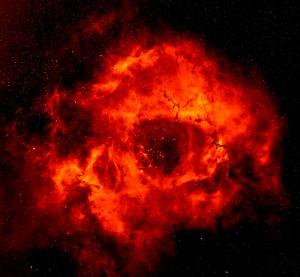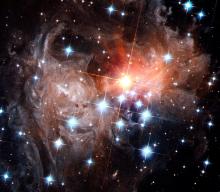Billowing clouds of gas and dust form the Rosette Nebula, a stellar nursery named for its resemblance to a rose. The nebula spans more than 100 light-years, and is giving birth to new stars. Several hot young stars inside the nebula produce ultraviolet energy that causes the surrounding gas to glow. The visible nebula is part of a much larger complex of gas and dust known as the Rosette Molecular Cloud. In all, it's given birth to about 2,500 stars in the last few million years. This view also shows ribbons of cold, dark dust, where new stars are most likely to be taking shape. [Nick Wright (University College London)/IPHAS Collaboration]
You are here
Unicorn Clouds
To the eye alone, the unicorn is a bust — there’s just not much to see. Look deeper, though, and the constellation Monoceros offers plenty to see. The list includes a couple of colorful stellar nurseries, which have given birth to thousands of stars.
The Rosette Nebula is named for its resemblance to a red rose. It’s a cloud of gas and dust that’s more than a hundred light-years across. Several young stars inside the nebula are especially hot and bright. They produce ultraviolet energy, which zaps hydrogen gas in the cloud, causing it to glow.
The visible nebula is part of a larger complex of gas and dust, known as the Rosette Molecular Cloud. It’s given birth to about 2500 stars, all within the last few million years.
Another big cloud in Monoceros is giving birth to new stars, too. It consists of several parts. There’s the Snowflake Cluster, which shines brightly. Nearby are the stars of the Christmas Tree Cluster, which — not surprisingly — form the outline of a Christmas tree. And a finger of dark dust extends “above” the tree — the Cone Nebula. It’s a cloud of cold dust that forms a silhouette against the warmer gas around it.
The nebulae should continue to churn out stars for millions of years — providing colorful decorations for the unicorn.
Monoceros is in the southeast as night falls, below and to the lower left of Orion the hunter. You need dark skies to see its stars — and a telescope to see its busy nurseries.
Script by Damond Benningfield
Get Premium Audio
Listen to today's episode of StarDate on the web the same day it airs in high-quality streaming audio without any extra ads or announcements. Choose a $8 one-month pass, or listen every day for a year for just $30.






